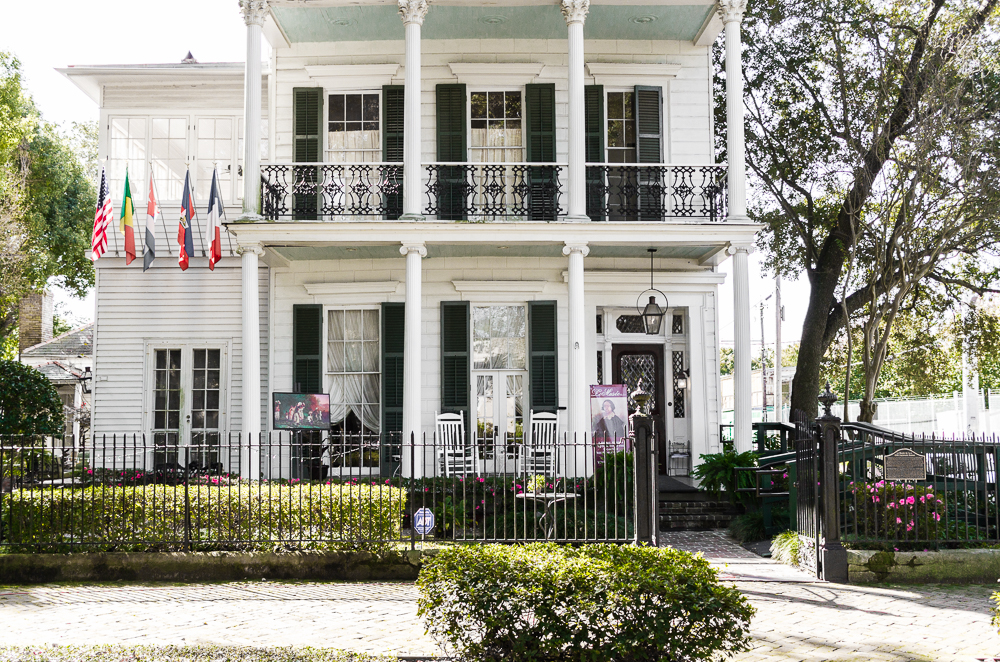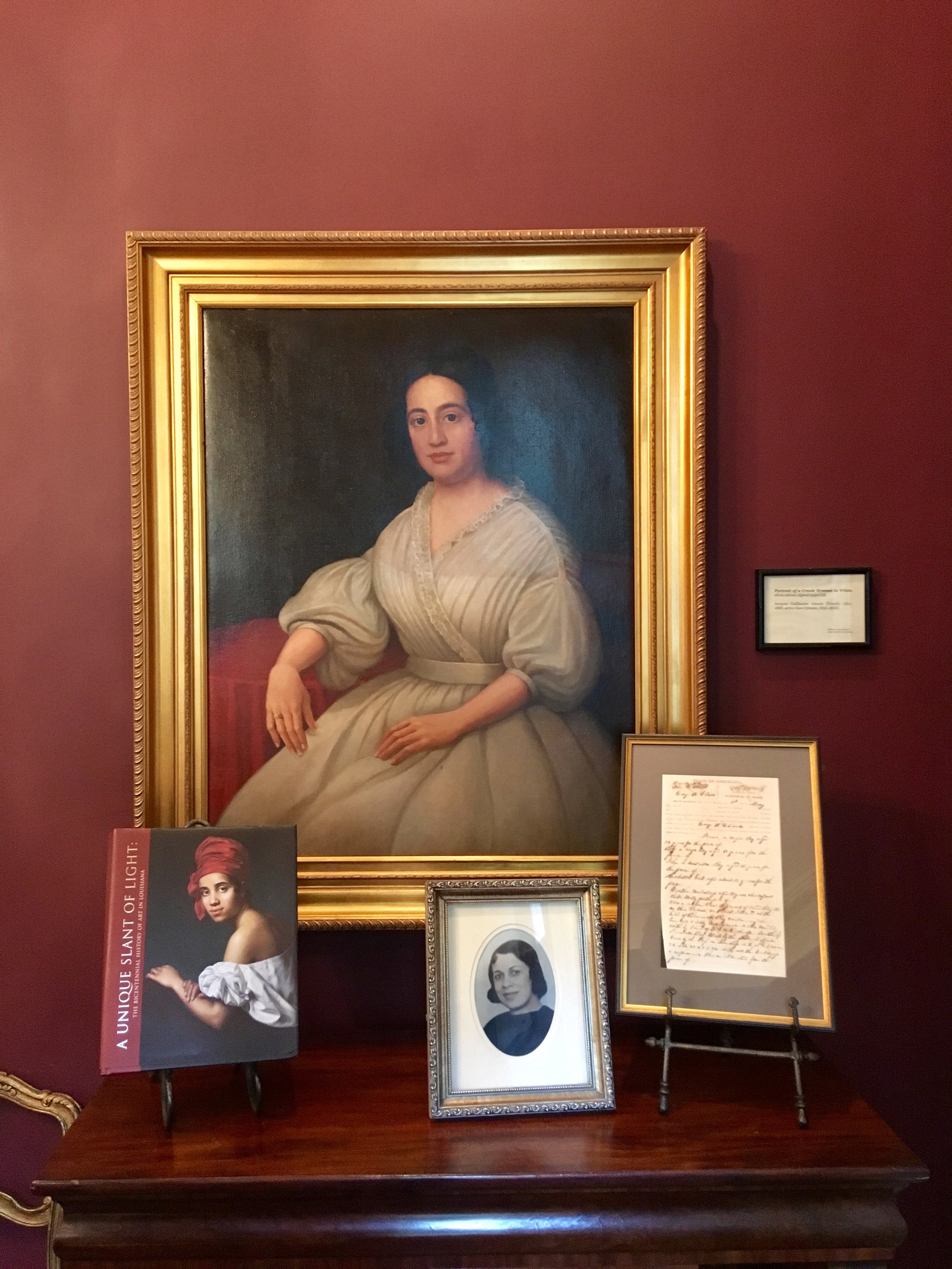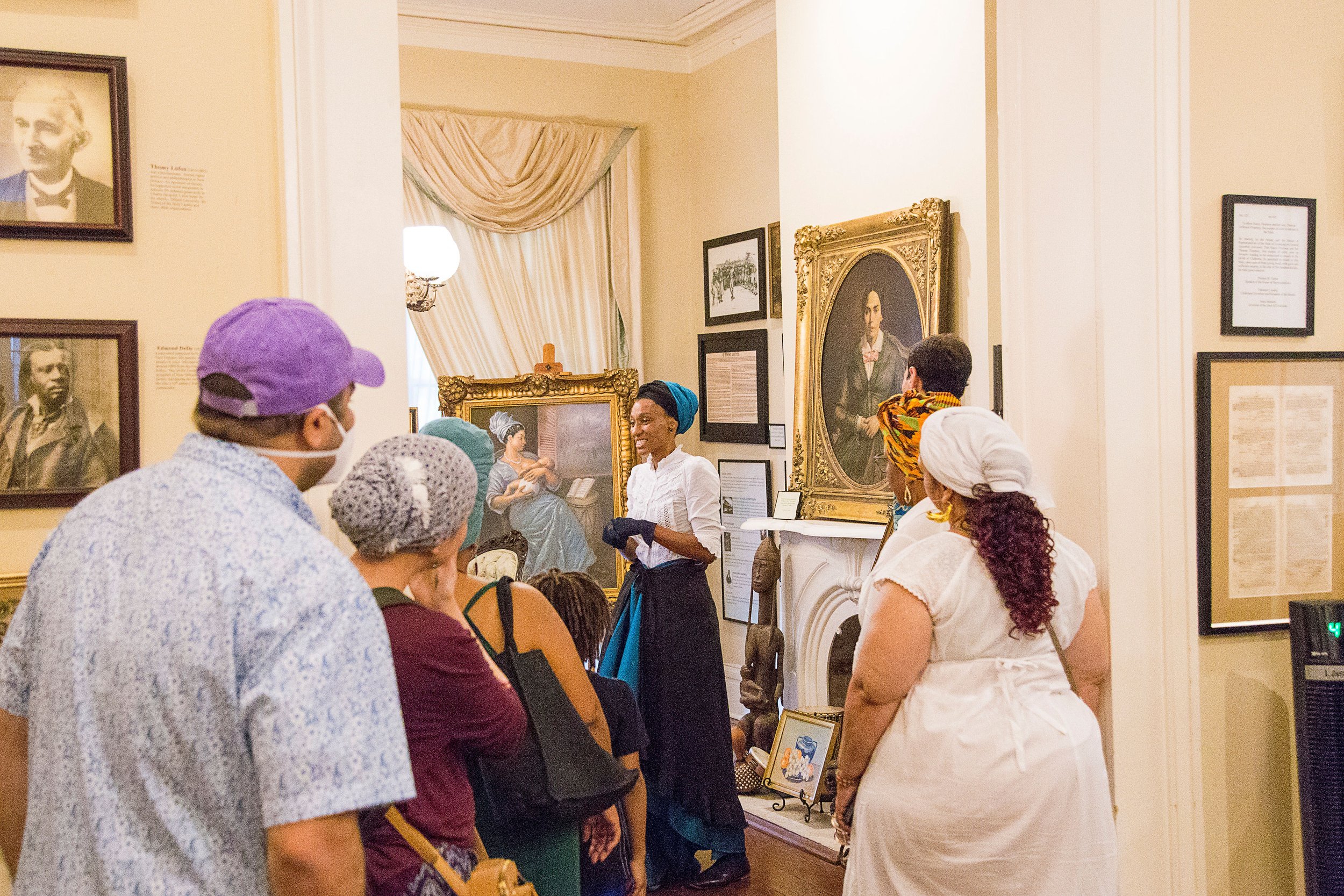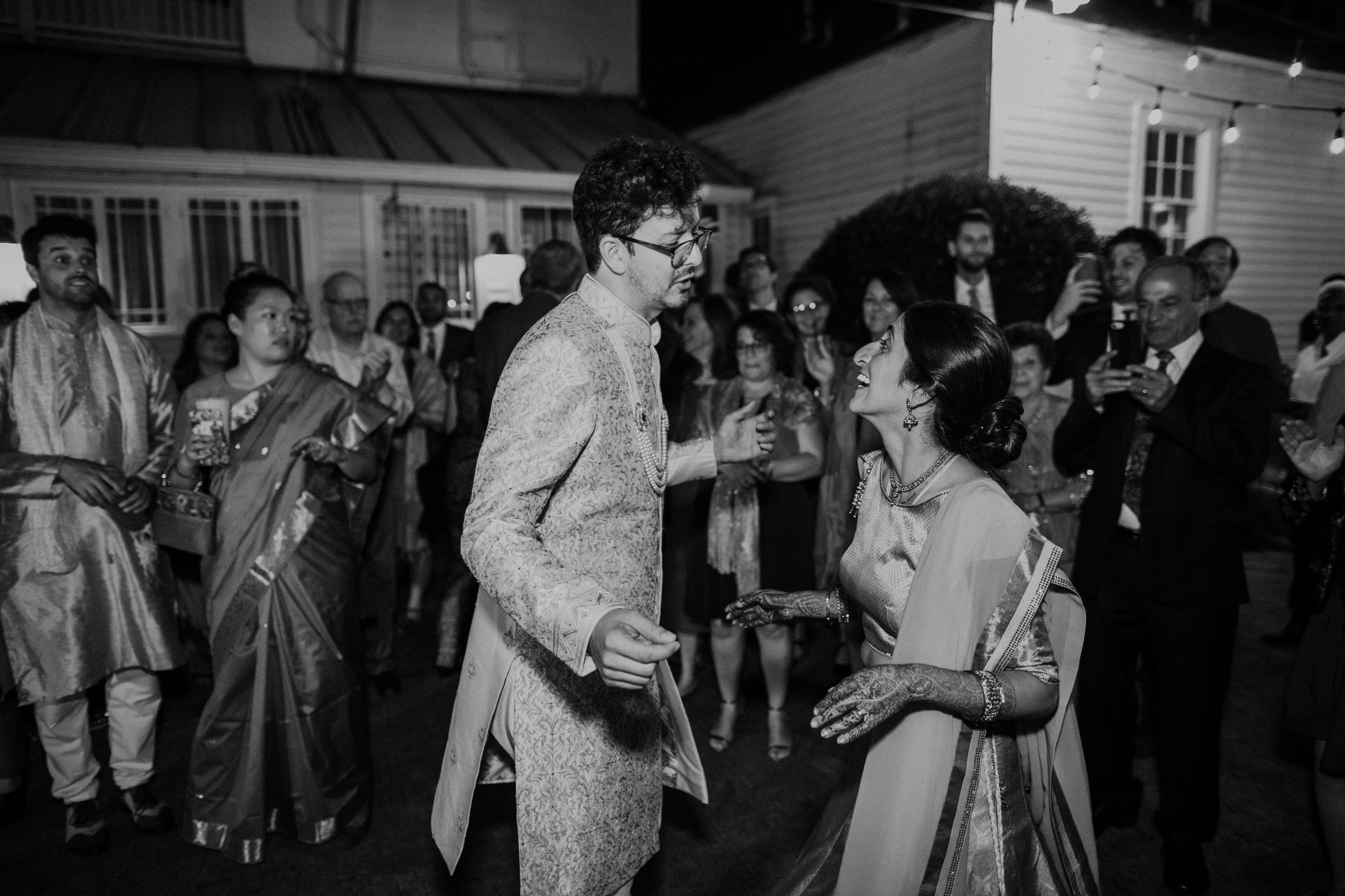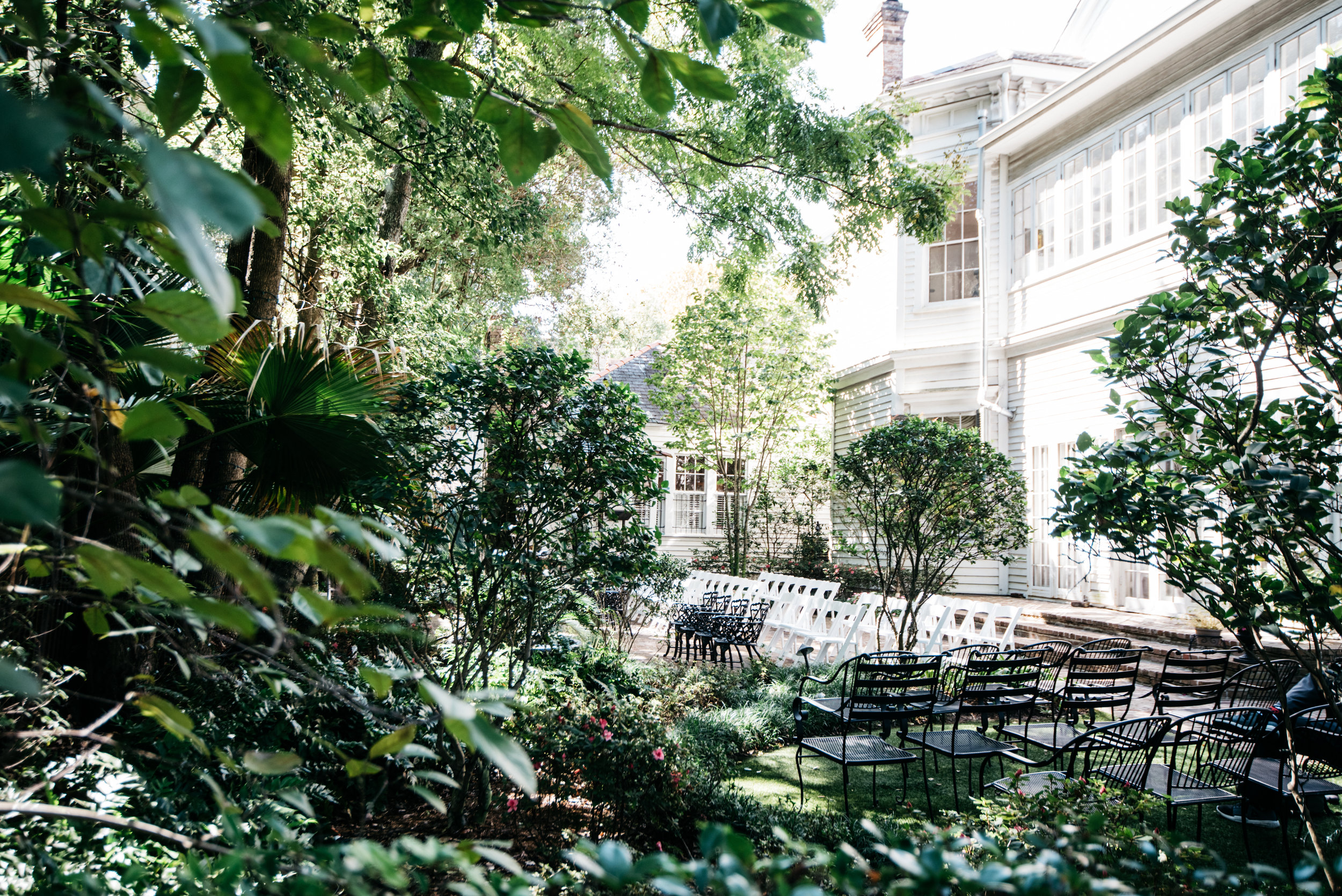About The House
Le Musee de f.p.c. is located on Esplanade Ave., which geographically translates into Esplanade Ridge. Esplanade Ridge historically passes through several prominent Black neighborhoods. The Sixth Ward, The Seventh Ward, and Treme. It's one of the highest points in the New Orleans metropolitan area and the principal reason that New Orleans was founded where it is, along the Mississippi River. The indigenous people of this region (Choctaw, Houmas, Chitimacha, and Biloxi) would use Esplanade Ridge as a trade portage from the big river (Mississippi River) to Bayou Saint John. Later they would do the same r when the French and the Spanish inhabited the area.
The building housing Le Musee de f.p.c was built in 1859 and the longest-living inhabitants of this property were a white Creole family. Until The McKenna’s purchased this property in the late 1990s.
What is Creole?
'Creole' means 'native to this land,' in case anyone is confused. The Portuguese first used the term to differentiate people born in the Western Hemisphere from those born in Portugal. The French and Spanish later adopted it for the same meaning. So, you could have two French parents, two Portuguese parents, or two Spanish parents, and be born in the Western Hemisphere and be Creole — meaning born here.
Who is Dr. Louis Charles Roudanez
-
Because a white Creole family owned this property, we've dedicated this museum to a freeman of color, Dr. Louis Charles Roudanez, whose portrait is in the first parlor. He was born in 1823 in Saint James Parish. Due to his parentage, he was afforded a primary education in New Orleans during the antebellum period. Then, like many of his peers, he went to Paris to further his education. After seven years, he left Paris with his first medical degree. Upon his return to the States, he attended Dartmouth College and earned a second medical degree. By 1851, he was back in New Orleans.
While not unique in terms of the city's free people of color population, what made him stand out was his decision in 1862; when New Orleans fell under Union occupation, he started a Black Republican newspaper — the first black newspaper in the South, entitled L'Union. It was a bi-weekly paper in which he pushed his political agenda, advocating for total abolition, the right to vote, and integrated public education. You can imagine this caused him some trouble. Ultimately, a scuffle with his editor led his funders to pull support from L'Union. But he was undeterred. The very next day, he started La Tribune de la Nouvelle-Orléans, the first African American daily bilingual newspaper in the U.S., which he self-funded from 1864 to 1868. In this paper, he continued discussing the ills of Reconstruction and the Freedmen's Bureau, while advocating for the newly freed population.
His political work caused so much trouble that he sent his wife, two daughters, and second-to-youngest son to Paris. They never returned, though he kept his oldest and youngest sons with him in New Orleans. All three became prominent doctors, however, three generations removed from Dr. Louis-Charles Roudanez, his family began to pass for white.
Because a white Creole family owned this property, we've dedicated this museum to a freeman of color, Dr. Louis Charles Roudanez, whose portrait is in the first parlor. He was born in 1823 in Saint James Parish. Due to his parentage, he was afforded a primary education in New Orleans during the antebellum period. Then, like many of his peers, he went to Paris to further his education. After seven years, he left Paris with his first medical degree. Upon his return to the States, he attended Dartmouth College and earned a second medical degree. By 1851, he was back in New Orleans.
While not unique in terms of the city's free people of color population, what made him stand out was his decision in 1862; when New Orleans fell under Union occupation, he started a Black Republican newspaper — the first black newspaper in the South, entitled L'Union. It was a bi-weekly paper in which he pushed his political agenda, advocating for total abolition, the right to vote, and integrated public education. You can imagine this caused him some trouble. Ultimately, a scuffle with his editor led his funders to pull support from L'Union. But he was undeterred. The very next day, he started La Tribune de la Nouvelle-Orléans, the first African American daily bilingual newspaper in the U.S., which he self-funded from 1864 to 1868. In this paper, he continued discussing the ills of Reconstruction and the Freedmen's Bureau, while advocating for the newly freed population.
His political work caused so much trouble that he sent his wife, two daughters, and second-to-youngest son to Paris. They never returned, though he kept his oldest and youngest sons with him in New Orleans. All three became prominent doctors, however, three generations removed from Dr. Louis-Charles Roudanez, his family began to pass for white.
Parlour 1
FRENCH. SPANISH. FRENCH. AMERICAN.
FRENCH COLONIAL LOUISIANA : 1718-1763, 1803
THE CODE NOIR : 1724
SPANISH COLONIAL LOUISIANA : 1763-1802
FOUR PATHWAYS OF FREEDOM
EDICT OF GOOD GOVERNMENT : Tignon Laws
When René De LaSalle discovered Louisiana in 1688, France was looking for a location that would allow them to have a foothold in the New World. This would also allow them to connect their land holdings and give them total domination of the Mississippi River—the Louisiana colony fits the bill.
Unfortunately, France had no economic ability to maintain or activate a colony at its discovery. But undeterred, France decided that to stave off its financial troubles, they would give the Louisiana colony to several private proprietors, the first being Antoine Crozat. Antoine has this money-making idea. He wants to mimic the Canadian fur trade in the Louisiana Territory. Unfortunately for him, he did not account for climate, and he would pump about $4 billion into the Louisiana colony and go broke trying to establish what he thought would be a booming economic industry.
Whatever his failings, it’s because of his investment that we will see settlers come into the region and establish forts at several points of interest. These are not French explorers; they are French Canadians tasked with establishing a colony. The two most important to our story are brothers Pierre and Jean Baptiste de Le Moyne. You may know them as Iberville and Bienville. By 1708, you start to see the clearing out of the Bayou Saint John area. Instead of using the river, these brothers would use Lake Pontchartrain as their point of entry. Following Antoine Crozat's economic decline, the French individuals would be approached by a Scottish man named John Law, a banker. John Law gives France the idea of creating a national bank and backing that bank with the Louisiana territory. Ultimately, he wants to make paper money or credit based on the Louisiana territory. However, he runs into a problem: no one is in the Louisiana Territory except for these Canadian frontiersmen. He begins to find ways to populate Louisiana enough to generate economic clout. He would have France forcibly send about 3,000 individuals into this region. France had a hard time sending proper citizens; they would send vagabonds, thieves, prostitutes, and drunkards, instead.
Louisiana became a penal colony, very similar to Australia. He also gets about 3,000 Germans who came into this region; they settled on what is now considered the Gold Coast of this country, which is Louisiana's famed River Road. Law also decided to maintain an agreement that had already been established with the French empire by using Senegambian individuals to bulk up the labor force. About 3,000 West Africans are forcibly sent into this region from 1721 to 1731 without undergoing a seasoning process. Seasoning itself is the brutal breakdown of a human being; it's where you strip them (Africans) of their name, language, and religion, ultimately making them docile to their colonizers. Many of the Caribbean Islands were known as “seasoning” plantations. For ten years, that did not happen in the Louisiana Territory. Instead, John Law’s Company of the Indies would purchase enslaved Africans without an intermediary, ultimately allowing these people to enter the colony with their culture intact.
Due to this increase in the African population, The French Canadians enacted Le Code Noir in 1724.
For reference, we have a version of Le Code Noir on the right wall, further back, closer to the window, where you can see all the articles of Le Code Noir translated in the order they were listed.
Le Code Noir:
The Code Noir has 59 articles. Here are some examples of this legal code:
Article No. 1: “...we enjoin all of our officers to chase from our islands all the Jews who have established residence there.”
Article No. 2: “All slaves that shall be in our islands shall be baptized and instructed in the Roman, Catholic, and Apostolic Faith.
Article No. 5: We enjoin all our subjects, of whatever religion and social status they may be, to observe Sundays and the holidays that are observed by our subjects of the Roman, Catholic, and Apostolic Faith.
Article No. 11: We forbid priests from conducting weddings between slaves if it appears that they do not have their masters' permission. We also forbid masters from using any constraints on their slaves to marry them without their wishes.
Article No. 47: Husband, wife, and prepubescent children, if they are all under the same master, may not be taken and sold separately. We declare the seizing and sales that shall be done as such to be void. For slaves who have been separated, we desire that the seller shall risk their loss and that the slaves he kept shall be awarded to the buyer, without him having to pay any supplement.
Article No. 59: We grant freed slaves the same rights, privileges, and immunities that are enjoyed by freeborn persons. We desire that they are deserving of this acquired freedom and that this freedom gives them, as much for their person as for their property, the same happiness that natural liberty has on our other subjects.
The Code Noir would give birth to our four pathways of freedom throughout the colonial era.
Four Pathways of Freedom
Self-emancipation. This was highly dangerous; you only had a 10% chance of survival. But if you made it beyond the outskirts of the city and successfully into the swamp, you could either become a part of a Cimarron or maroon colony, which is a band of two to 500 self-emancipated enslaved individuals, or you can assimilate into an indigenous culture that lived closer to the swampland.
Manumission. The benevolent act of your owner freeing you. The oldest document in this museum was created in 1761 and is of a woman and her mulatto son being given their freedom by their owner.
Military service. Again, the Louisiana colony primarily functions as a military outpost. Militiamen face yellow fever, malaria, and exposure to natural disasters. In addition to constant skirmishes with the indigenous. Ultimately, many of these French militiamen die off causing the colony to supplement their loss with enslaved Africans.
Coarctation, a system of self-purchase instituted by the Spanish post 1763. The Spanish encouraged this system, as they believed that it would curb rebellion amongst the enslaved population.
Because of these four pathways to freedom, Louisiana, New Orleans in particular, would see ⅓ of its population become free persons of color (gens de couleur libres) by 1801.
Edict of Good Government (Tignon Law), established by Esteban Miro (1786) decreed that Black women in New Orleans wear a headscarf, or tignon, in public. The decree was intended to distinguish Black women from white women:
Please proceed to Parlor Two.
Parlour 2
ANTEBELLUM LOUISIANA
Haitian Revolution, 1791- 1803
Louisiana Purchase, 1803
Abolition of the Transatlantic Slave Trade, 1808
The beginning of the Domestic Slave Trade, 1809
As we enter the second parlor, this room focuses on the antebellum period, which lasted from 1803 to 1860. This era is known as the best and worst times for free people of color because of the fantastic cultural and economic shifts that directly or indirectly affected free people of color as they lived throughout this period.
The Louisiana Colony would change drastically as we got into the 1800s because of four events. The first was the Haitian Revolution (1793–1803), which doubled the population in New Orleans. By 1800, New Orleans held 12,000 people, but by the 1830s, it was holding 33,000 people, many of them refugees of the Haitian Revolution. The second is the Louisiana Purchase. After losing Haiti, the richest colony in the Western Hemisphere, Napoleon Bonaparte sold the Louisiana territory to the Americans for $15 million in 1803. Resulting in an influx of Anglo-Saxon Protestants into an Afro-Creole, Catholic, Francophone-speaking city. By the 1840s, 100,000 individuals lived in the city of New Orleans.
The city proliferated during the antebellum period, and at the same time, free people of color began to face a harsher racial regime because Americans believed that blacks were racially inferior and uncontrollable unless enslaved.
The third was the abolishment of the Transatlantic Slave Trade in 1808, and the fourth was the immediate start of the domestic slave trade that same year.
New Orleans became known as the Queen of the South throughout the antebellum period. New Orleans would be the third most prosperous city in this country and the largest city in the South.
Again, these are the best and worst times for free people of color. It is good because free people of color are gaining wealth. It has been estimated that by 1865, they were paying $1.5 million in property taxes. We have books in this room that show some of the property owned by free people of color. The majority of those property owners are Black women.
Free people of color have an 80% literacy rate, which is impressive for any ethnic group of this time. They speak upwards of four languages: English, French, Spanish, and German. This allows them to conduct business at every level. These people became master tradesmen, artisans, and skilled businessmen as the city grew economically.
Also, these people became movers and shakers in this society, becoming world travelers. Almost every free person of color who is worth their salt is born during this time. We do have a Wall of Fame located to your left. This is not an exhaustive list of the free people of color who lived in the city, but these are some of our favorites.
However, the harsh realities of their status in society became apparent by the 1830s; free people of color must carry passes and register with their municipality every other year (this only applies to newly arrived free people of color or people who attain freedom during this period). The Americans instituted 60-day consecutive rules, under which a free person of color could not influx into the state of Louisiana and stay beyond 60 straight days. If they did, they could face enslavement.
Free people of color had curfews placed on them; they had to be in their homes by 9:00 PM (the same as the enslaved population). It became illegal for people of color to educate their children. The age of manumission will change from 25 to 32.
It would become illegal for Black individuals to represent themselves in court because they were either considered chattel property or noncitizens of the country.
However, even with all the hostile policies surrounding free people of color, they still are economically benefitting from the system of slavery. And are looking for ways to reinforce the idea that they are citizens of Louisiana. So, it comes as no surprise that when Louisiana seceded from the Union after Abraham Lincoln was elected president in 1860 and states began seceding from the Union, free men of color actively volunteered to fight for the Confederate States of America—1,100 of them volunteered. These Free Men of Color wanted to validate their citizenship. They faced increased disenfranchisement but still had access and upper mobility. Also, there was an immense fear that they would have their property revoked and that they would be terrorized if they did not vocalize their support. What's ironic is that even though the Confederacy initially applauded these men, they never became an official part of the Confederate Army. Eventually, these same men would turncoat and become a part of the Union forces when the city of New Orleans fell under Union occupation in the spring of 1862. They would make up the Louisiana Native Guard and participate in the Battle of Port Hudson, a decisive battle that would see the Union army take total control of the Mississippi River.
Please proceed to Parlor Three.
Parlour 3
CIVIL WAR & RECONSTRUCTION
Haitian Revolution, 1791- 1803
Louisiana Purchase, 1803
Abolition of the Transatlantic Slave Trade, 1808
The beginning of the Domestic Slave Trade, 1809
This last parlor is dedicated to the Civil War and Reconstruction. After these men fought in the decisive battle at Port Hudson, even though they were touted for their bravery and used as propaganda for the Union Army, they were still gravely mistreated. By 1864, many of these men began to be stripped of their officerships for the simple fact that white foot soldiers would not obey black commanding officers.
Ultimately, these free men of color would give up military service and begin to establish a social movement to seek equal rights following the end of the Civil War.
If you come to the back wall, you will see a petition. It holds the signatures of 850 free men of color from New Orleans who organized to guarantee suffrage following the Civil War.
In this petition, they state, "We pay $15 million in property taxes. We are masters of industry. But most importantly, these men laid down their lives for this country, the Union."
They would send this petition with two delegates to hand-deliver it to Abraham Lincoln: Captain Arnold Bertenneau and Jean Baptiste Roudenaz, Dr. Louis Charles Roudanez's older brother. Once in D.C., they met with several senators and members of the House of Representatives. They then met with Abraham Lincoln, who initially believed them to be white sympathizers. It took him about 30 minutes and members of his cabinet to clarify that these were free men of color from New Orleans.
As they delivered their speech, Abraham Lincoln listened intently but was ultimately non-committal. He shelved the petition, stating that if the state wanted them to vote, they could vote—something Louisiana was not ready to do.
The first rendition of Louisiana's reconstructed constitution was done begrudgingly, allowing the 13th Amendment to pass. This Amendment freed the enslaved population but did not include universal suffrage.
In total, Reconstruction lasted 14 years, 10 days, and 7 hours; however, it was only radical from 1870 to 1877. For the seven years that Reconstruction happened successfully, you'd see the election of Black members into the House of Representatives and Congress, who revised the Louisiana constitution to include Bill of Rights articles and public education articles, which promoted integrated public education. We also held a successful transportation boycott that would incorporate the streetcar system in the city.
Again, this was short-lived. New Orleans is one of the first cities to see an initial rollback of progressive radical Republican policies.
Thank you for visiting Le Musee de f.p.c. If you have any questions, they can be directed to the gallery guard.


